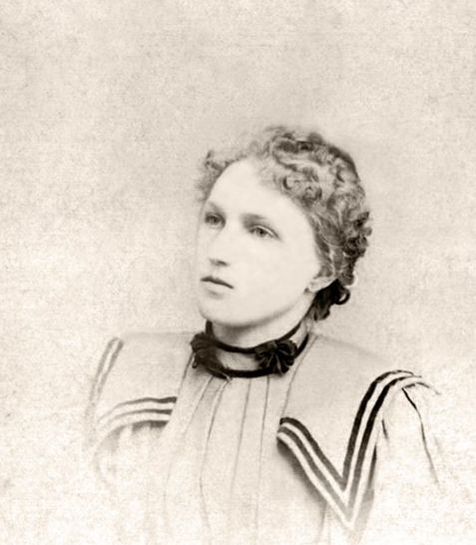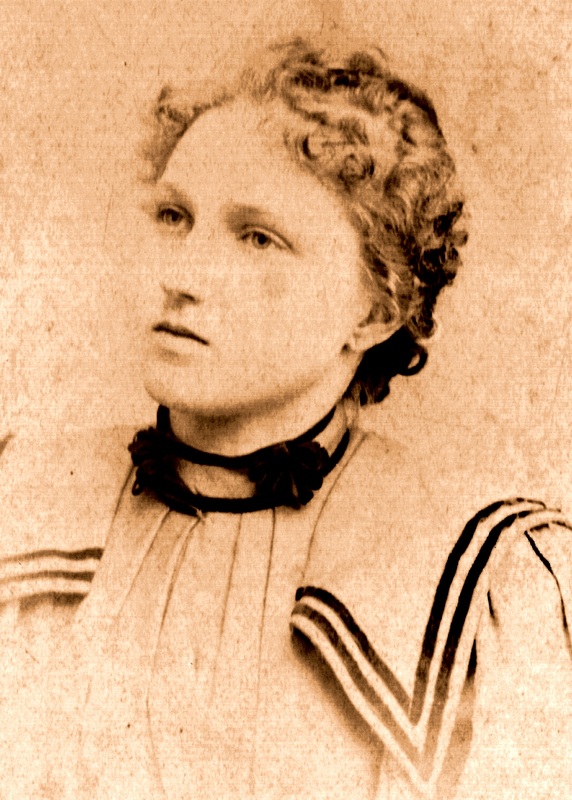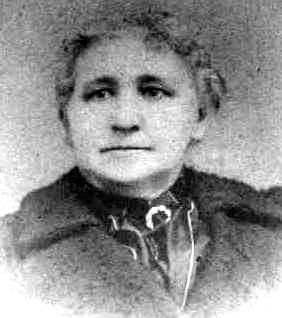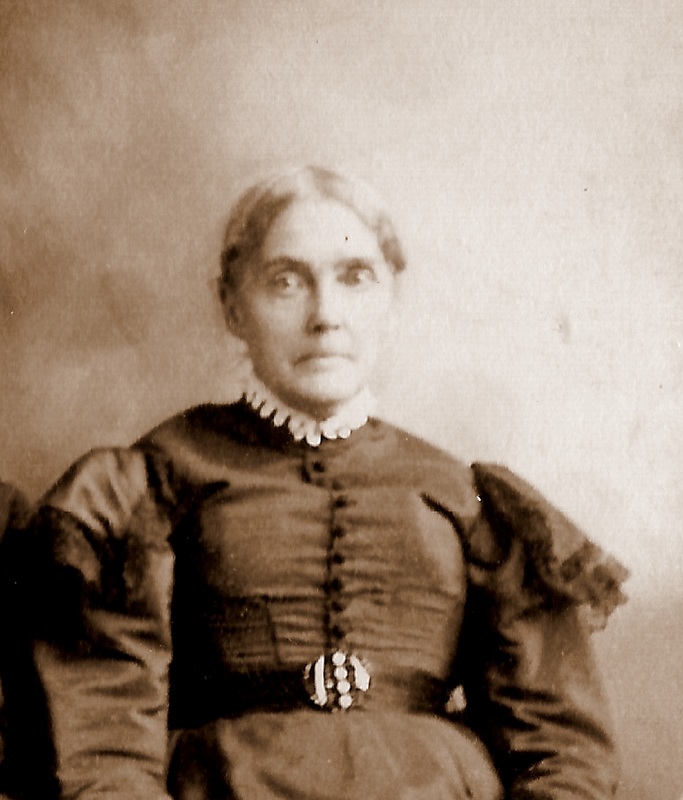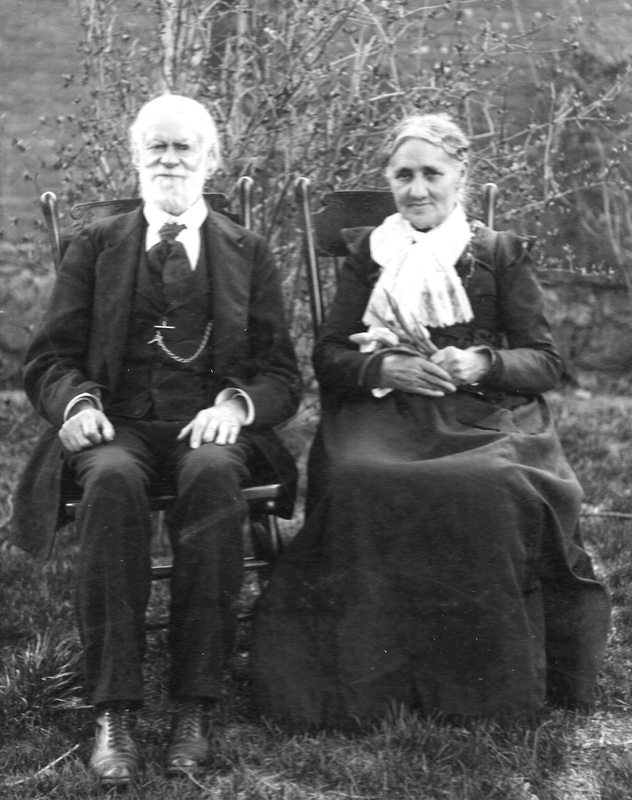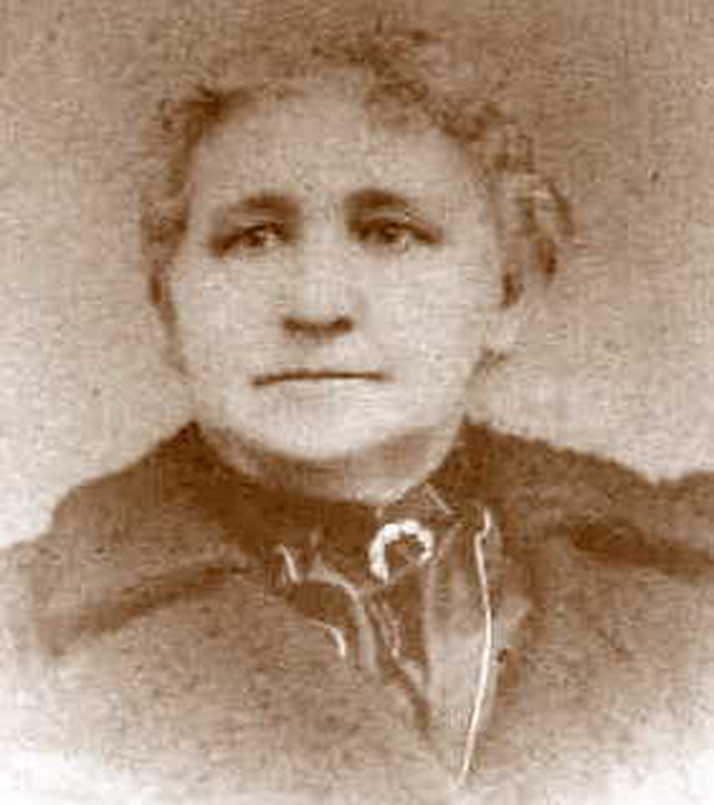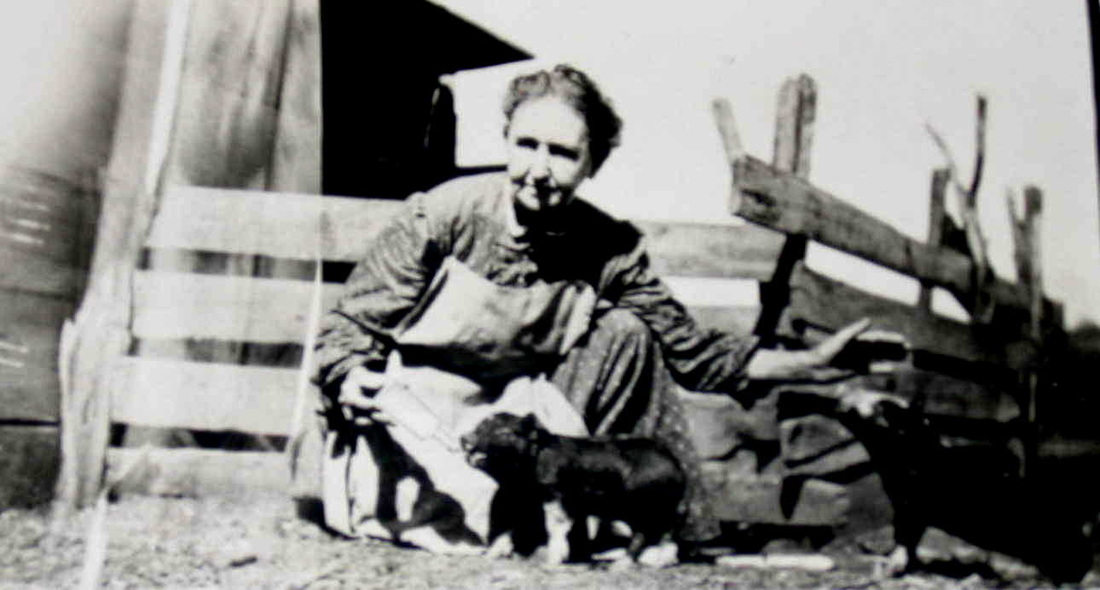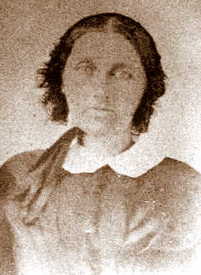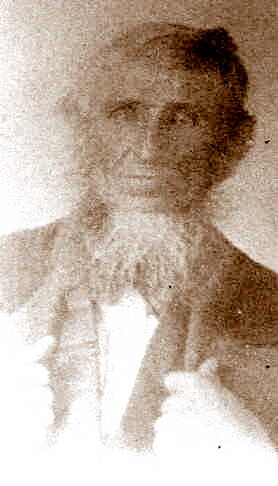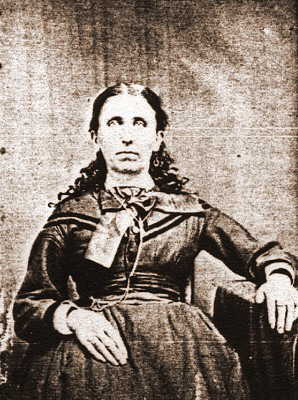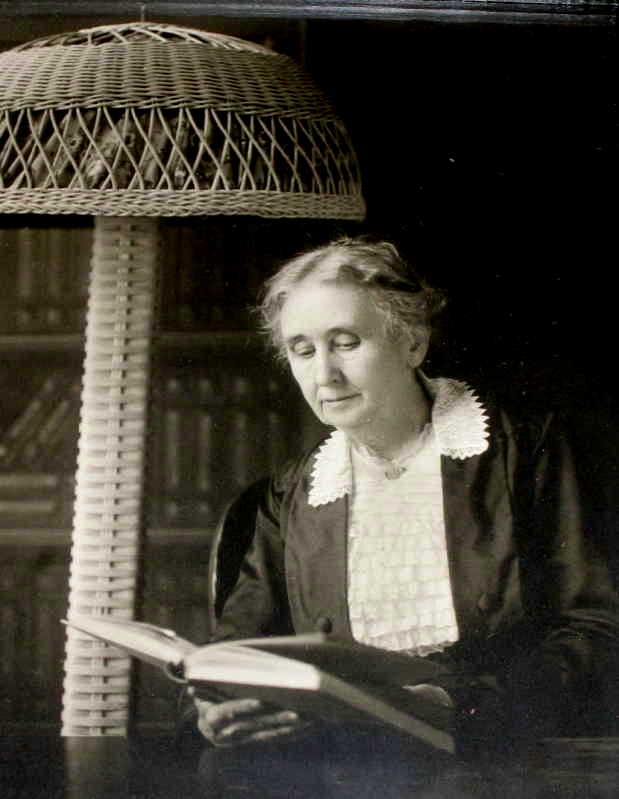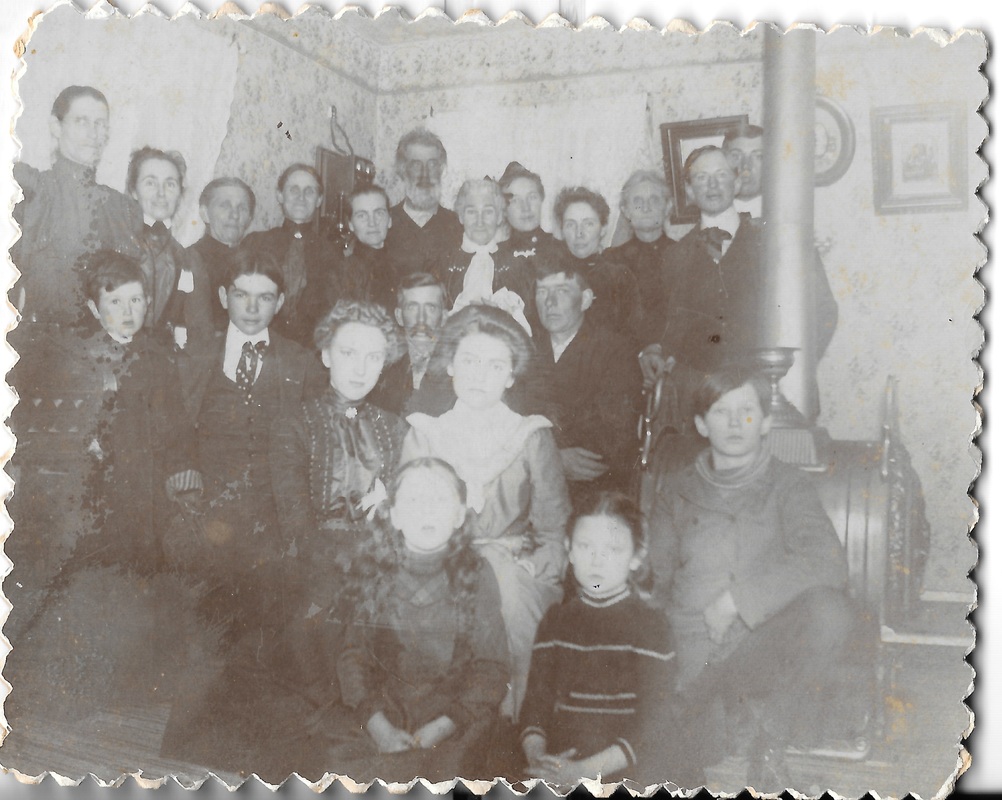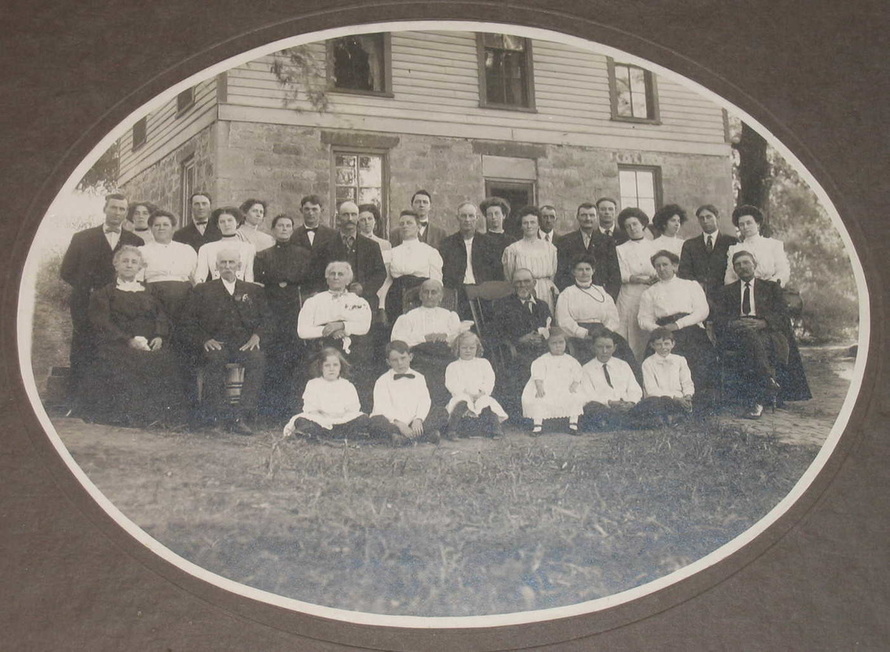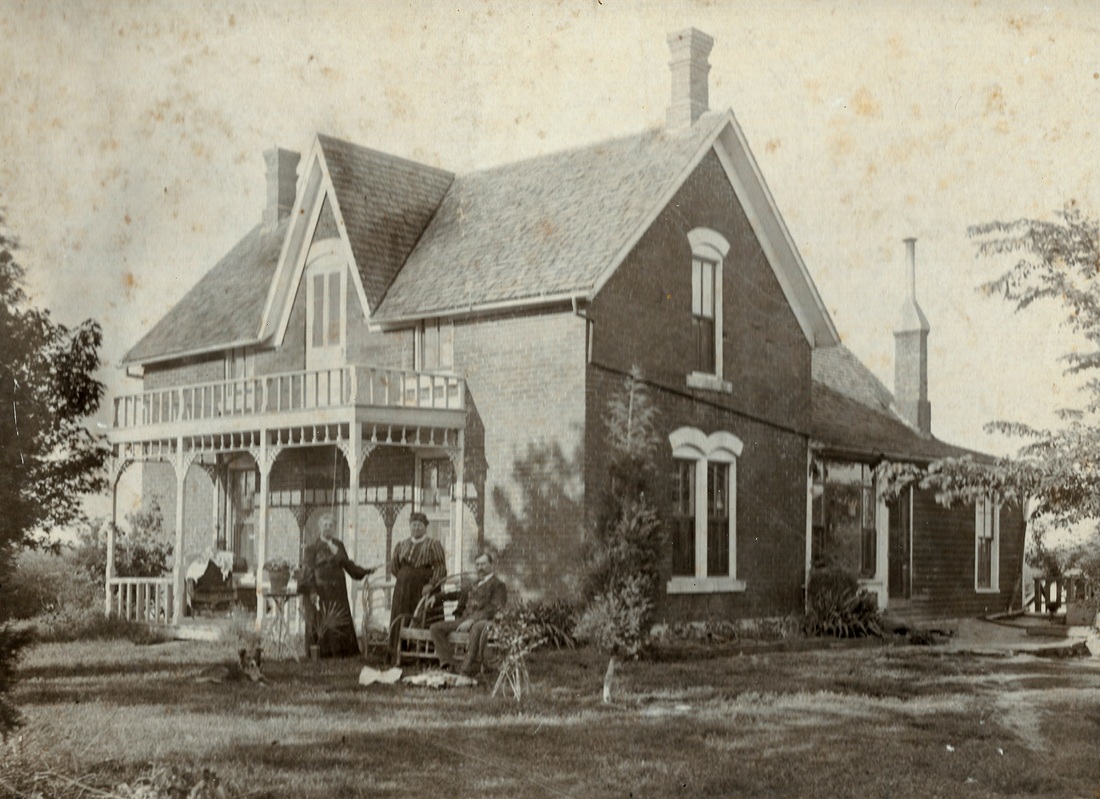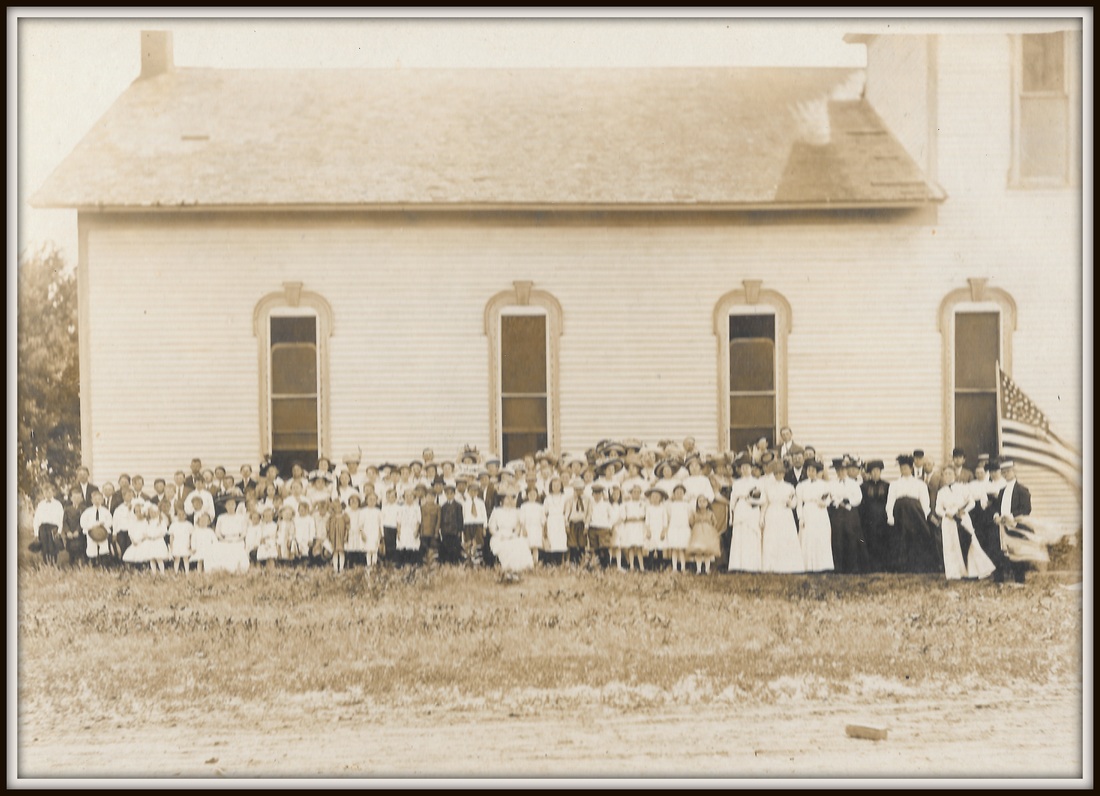the gentle gender
stories of pioneer women of table rock
compiled by sharla cerra
Sweet as honey, some of them tough as the native dried cottonwood. These are stories of the first settlers. Some consist of little more than odds and ends, but this is what we know about them.
More stories will be added, but below you will find stories about first-wave settlers like Laura Mumford, and her mother Melissa; about Caroline Dimon, who was visited by Indians one winter night. There are stories about the hale and hardy woman known as "Mrs. Dr. Mary B. Fox" and her extended family. There is a story about Elizabeth Ball and a horse thief. Read on.
Sharla, October 2016
More stories will be added, but below you will find stories about first-wave settlers like Laura Mumford, and her mother Melissa; about Caroline Dimon, who was visited by Indians one winter night. There are stories about the hale and hardy woman known as "Mrs. Dr. Mary B. Fox" and her extended family. There is a story about Elizabeth Ball and a horse thief. Read on.
Sharla, October 2016
Laura mumford (1875-1965)
&
her pioneer mother
melissa huntley mumford (1842-1940)
Photo 2008. This is Laura Mumford (1875-1965), the daughter of pioneers in Elk Creek and Table Rock.
We have this photograph under unique circumstances. Laura was apparently a friend of Nellie Griffing Boyd, daughter of another of the first families of Table Rock. When Mrs. Boyd died in New York, her son Kenneth sent the Historical Society photographs that he described as "friends and neighbors of mother's" that meant little to him; he had reserved the family photographs for himself. Some of the photographs, like this one, either Nellie or Mr. Boyd had annotated names on the back. Sadly, we have no pictures of Nellie herself, but because of Mr. Boyd's generosity, we do have a number of rare and precious photographs of some of the other first settlers, including this one of Laura.
Laura's grandparents -- the Martin Mumfords -- were some of the first settlers in the District, coming before the Civil War; this family included children Luther (1831-1882), Ruby (1836-1895), Frances (1839-1911), Thomas (1840-1914), and Henry (1846-1877).
Luther and Henry, the oldest and youngest, both fought in the Civil War.
Henry was Laura's father. He married Melissa Huntley, the youngest of a family of nine children. She had grown up near Elk Creek, her family coming here in 1856.
The obituary of Laura's mother Melissa offered some gratifying information:
We have this photograph under unique circumstances. Laura was apparently a friend of Nellie Griffing Boyd, daughter of another of the first families of Table Rock. When Mrs. Boyd died in New York, her son Kenneth sent the Historical Society photographs that he described as "friends and neighbors of mother's" that meant little to him; he had reserved the family photographs for himself. Some of the photographs, like this one, either Nellie or Mr. Boyd had annotated names on the back. Sadly, we have no pictures of Nellie herself, but because of Mr. Boyd's generosity, we do have a number of rare and precious photographs of some of the other first settlers, including this one of Laura.
Laura's grandparents -- the Martin Mumfords -- were some of the first settlers in the District, coming before the Civil War; this family included children Luther (1831-1882), Ruby (1836-1895), Frances (1839-1911), Thomas (1840-1914), and Henry (1846-1877).
Luther and Henry, the oldest and youngest, both fought in the Civil War.
Henry was Laura's father. He married Melissa Huntley, the youngest of a family of nine children. She had grown up near Elk Creek, her family coming here in 1856.
The obituary of Laura's mother Melissa offered some gratifying information:
She has enjoyed recounting those early days, and the things they had to eat during their first winter: corn bread, venison and turkey. |
On their new homestead, Henry and Melissa had a little girl in 1870, Alice, then in 1871 a little boy, Martin. In 1872, little Alice died and was buried in the Table Rock Cemetery. That same year, Henry became very ill. The family moved into town. In 1875, Laura was born there. Henry died in 1877, leaving Melissa with two-year-old Laura and six-year-old Martin.
Melissa struggled onward:
Melissa struggled onward:
Before her husband's death in 1877, she had been teaching some in addition to caring for her family, and continued teaching in Table Rock and nearby rural schools, until 1886, when she was united in marriage to John N. Richardson, a prominent business man in Table Rock [and widower. Martin would have been 15, Laura 11]. |
Melissa's obituary describes Martin (1871-1931) as a successful business man in St. Joseph, Missouri. .
Of Laura herself, we know little more. Her husband, Carl Clifton Covert, who went by C. C., was a dentist. He also enjoyed music. He is in a 1910 picture taken in Table Rock of the Mandolin Band (which picture is posted on this website).
Dr. Covert died in 1946. Laura died in 1965 at the age of 89.
Laura and Dr. Covert had a little girl, Marjorie. Marjorie ended up in New Jersey and married to a man with the last name Van Roosbroeck. Laura apparently joined Marjorie there, as she died at a nursing home in New Jersey. If Marjorie had any children, they were gone by the time Laura died in 1965 because Laura's obituary lists Majorie as her only survivor. "Miss Marjorie" had lived in Albany, Missouri, as did her parents, in 1939, as noted in the obituary of her grandmother, Melissa Mumford Richardson.
Laura's brother Martin, who died 30 some years before her, apparently had no children. When Laura's daughter Marjorie died -- and we cannot ascertain when -- that was the end of Henry Mumford's line. Laura and her mother Melissa seem to have been women many would like to have known.
Laura's body was brought back to Table Rock, where, after a funeral at the Methodist Church, the church of her family since the 1850s, Laura was put to rest in the Table Rock Cemetery.
Laura and her family except her brother, her daughter, and her son-in-law are buried in a family section in the Table Rock Cemetery. The grave of her father, Henry Mumford, and her little sister Alice are the only graves that are marked. But beside Henry also lie Laura's mother Melissa, Laura, and Dr.Covert. Laura's step father John Richardson is buried only a little ways north of them, with his first wife. Where are Marjorie and her husband? Did they have children? We wish we knew.
Of Laura herself, we know little more. Her husband, Carl Clifton Covert, who went by C. C., was a dentist. He also enjoyed music. He is in a 1910 picture taken in Table Rock of the Mandolin Band (which picture is posted on this website).
Dr. Covert died in 1946. Laura died in 1965 at the age of 89.
Laura and Dr. Covert had a little girl, Marjorie. Marjorie ended up in New Jersey and married to a man with the last name Van Roosbroeck. Laura apparently joined Marjorie there, as she died at a nursing home in New Jersey. If Marjorie had any children, they were gone by the time Laura died in 1965 because Laura's obituary lists Majorie as her only survivor. "Miss Marjorie" had lived in Albany, Missouri, as did her parents, in 1939, as noted in the obituary of her grandmother, Melissa Mumford Richardson.
Laura's brother Martin, who died 30 some years before her, apparently had no children. When Laura's daughter Marjorie died -- and we cannot ascertain when -- that was the end of Henry Mumford's line. Laura and her mother Melissa seem to have been women many would like to have known.
Laura's body was brought back to Table Rock, where, after a funeral at the Methodist Church, the church of her family since the 1850s, Laura was put to rest in the Table Rock Cemetery.
Laura and her family except her brother, her daughter, and her son-in-law are buried in a family section in the Table Rock Cemetery. The grave of her father, Henry Mumford, and her little sister Alice are the only graves that are marked. But beside Henry also lie Laura's mother Melissa, Laura, and Dr.Covert. Laura's step father John Richardson is buried only a little ways north of them, with his first wife. Where are Marjorie and her husband? Did they have children? We wish we knew.
pioneer caroline dimon (1826-1905)
|
This is pioneer Caroline Dimon 45 years after she arrived in Table Rock.
She and her husband Charles were one of at least 150 families funneled here in 1856 and 1857 by the Nebraska Settlement Company. Caroline was born to a large family in Pennsylvania in 1826; her parents were Asher and Matilda Woodward. She was the oldest of 11 children. In 1852, when she was 26, she married New-Jersey born Charles Dimon. In 1857, she and Charles took off on the journey of their life, to far off Nebraska. As did the other families directed there by the Nebraska Settlement Company, their route was a river boat down the Mississippi then up the Missouri River. Many of the families were able to travel as far as Aspinwall, a little river town east of Nemaha, before disembarking. However, Caroline and Charles could get only as far as Weston, Missouri, near Kansas City. The river was full of ice and not navigable beyond there. Charles bought a yoke of cattle and a wagon and they drove up through Kansas.They arrived in Table Rock on April 4, 1857. They were each 31 years old. Caroline and Charles took a homestead on a quarter-section of prairie three miles south of Table Rock, on the east side of the Nemaha. On the 1860 territorial census they are listed between John Williams and Russel Sampson, so those were presumably their closest neighbors. Pawnee Indians sometimes roamed the countryside around Table Rock. It seems they were seen as some homeless people are today, just looking for a hand out. That the settlers were settling on what had long been an area where they seasonally traveled to secure food and livelihood is never mentioned. They were sent away to a reservation in about 1878, which is hardly mentioned, and some occasionally came back to see their old home. It seems that the Indians did no one any harm in the end. Yet people were cautious about them. A few stories about encounters are preserved. One is from Caroline. One day a band of Indians came to her home. Charles was away: |
Seating themselves around the fire [they] made themselves quite at home, much to Mrs. Dimon’s alarm. When the fire needed replenishing she did not dare to go for firewood, fearing that her unwelcome guests would steal something while she was away. But when the temperature of the room became too cold for them, they found their way to the woodpile, returned to the house laden with fuel, and rebuilt the fire themselves, and prolonged their visits for some time. |
|
One of the other Table Rock families were Hiram and Nancy Billings and little children James, Tilman, and Nancy Josephine, born in 1853, 1857, and 1859. Mrs. Billings died in 1861. When the Civil War broke out, Hiram went back to Ohio to enlist, probably with family or friends. Holly Brinkman, the great great granddaughter of little Nancy Josephine shares her family’s history, that little Nancy Josephine -- then only 2 years old -- went to live with Caroline and Charles and they adopted her. Nothing is known of what happened with Tilman, then 4, and James, then 8.
|
The Dimons had three other children: Caroline and Charles had four children: Nancy, born in 1859; George, born in 1861; Eva, born in 1863; and Anna, born in 1878. Given that Caroline was 52 when Anna was born, it seems likely that Anna, too, was adopted, but we have no information about that.
In about 1902, Caroline and Charles celebrated their 50th wedding anniversary. Charles died that Fall. Caroline lived three more years, passing on in 1905 at the age of 79. She is buried in the Table Rock Cemetery with Charles and Eva, in the northeast quarter.
As to their children, Nancy lived to see her 100th birthday. She married Martin Higinbotham in 1879. Great great granddaughter Holly Brinkman remembers hearing that “Nancy was a really beautiful woman, and Martin adored her.” Nancy and Martin lived in Table Rock for at least three years, where two children—Bert and Gracie – were born. Three other children, Blanche, Roy, and Nellie were born in Kansas. In the end, Nancy lived in Colorado. A newspaper article about her 100th birthday described her as “chipper.”
Little Eva lived only a month, and is buried with Charles and Carolina.
Of George, we know nothing.
Of Anna, we know that at age 24, we can see that she was a lovely young woman, as she is seated between her parents in a photograph taken on the occasion of their 50th wedding anniversary. What happened to her, did she have a long and happy life like her older sister Nancy? We don't know. We can only hope.
In about 1902, Caroline and Charles celebrated their 50th wedding anniversary. Charles died that Fall. Caroline lived three more years, passing on in 1905 at the age of 79. She is buried in the Table Rock Cemetery with Charles and Eva, in the northeast quarter.
As to their children, Nancy lived to see her 100th birthday. She married Martin Higinbotham in 1879. Great great granddaughter Holly Brinkman remembers hearing that “Nancy was a really beautiful woman, and Martin adored her.” Nancy and Martin lived in Table Rock for at least three years, where two children—Bert and Gracie – were born. Three other children, Blanche, Roy, and Nellie were born in Kansas. In the end, Nancy lived in Colorado. A newspaper article about her 100th birthday described her as “chipper.”
Little Eva lived only a month, and is buried with Charles and Carolina.
Of George, we know nothing.
Of Anna, we know that at age 24, we can see that she was a lovely young woman, as she is seated between her parents in a photograph taken on the occasion of their 50th wedding anniversary. What happened to her, did she have a long and happy life like her older sister Nancy? We don't know. We can only hope.
more about caroline
Here is the location of Caroline and Charles' homestaed. This map was created by Doralyn Steiner Cheney and appears in her wonderful book, Stories of Settlers Along the Nemaha, which is about settlers along the Nemaha River prior to the Civil War.
Photo 83 is a photo taken on the occasion of the 50th wedding anniversary of Carolyn ad Charles. A list of the people was taped to the back of the picture and includes other first settlers such as Lydia Giddings Gere Holmes and Benjamin Ball. Front row: ___ Stewart, ____ Phillips, Arthur Scism, Hazel Taylor, Mr. Dimon, Anna Dimon, Mrs. Dimon, Frances Hales, Anna Wilson, Harland Taylor, Mrs. McCaslin (Laura? Covert is added in a note). 2nd row: M. H. Marble, Mrs. Richardson, Nettie Wilcox, Mrs. W. H. Wilson, Lydia Holmes, Mrs. Sam Wright, Uncle Ball (Benny), Auntie Ball, Della Griffing, Mrs. James Talbot, James Talbot, Taylor, Mrs. Frank Taylor; 3rd row: Mrs. M. H. Marble, Clara Scism, Mrs. Stewart, Mrs. C. I. Norris and “Mr. C. H.?” Mrs. Fannie C. Norris, Mrs. J. W. Shaw, Mrs. W. A. Conklin, Mrs. O. W. Griffing, Mrs. Rice Martin, Rev. ____ Shamel, O. W. Griffing.
Photo 684 of the Table Rock Historical Society, another photo taken on the same occasion, just Charles and Caroline. They were both 76.
Their adopted daughter Nancy Josephine in 1959:
Sources for this story about Caroline Dimon include the Dimon tombstone in the Table Rock Cemetery; Chapman's History of Johnson and Pawnee County, Nebraska; Andreas' History of Nebraska; the book Stories of Settlers Along the Nemaha by Doralyn Steiner Cheney, copyright 2016; the 1860 territorial census, the Ancestry public family tree of Barb Spuhler, the Ancestry public family tree of Holly Brinkman, and communications with Holly Brinkman. Thanks to Holly for sharing the newspaper clipping about Nancy Josephine's 100th birthday!
mrs. dr. mary b. fox (1837-1916)
civil war widow, single mother, homesteader
|
I am fascinated by the historic Table Rock Cemetery. Although the Cemetery Association was formed in 1882, the cemetery is much older. Burials there go back to 1857. I am especially interested in the stone for a woman who died 100 years ago this year (2016). It is at the top of the southeast quarter of the cemetery; it is a huge stone. “Dr. Mary B. Fox” is all it says. Smaller stones spread to each side, none with a last name. When first I saw these stones, the names meant nothing to me: “William L.,” 1851-1927; “Minnie J.,” 1856-1937; “Mother,” 1837-1916; Sadie, 1861-1869; “Awilda L.,” 1858-1928; and Charles H., 1864-1916. It is Mary Fox, her daughters, and their husbands. I have learned some things about Mary and her extended family. Mary's maiden name was Kerns. Her parents were Nicholas and Sarah Kerns and they were married in 1832; Sarah was 17, Nicholas 22. Mary was Nicholas and Mary's second child. She was born in Fayette City, Pennsylvania on May 6, 1837. Mary's sister Margaret was older, and after her followed eight more brothers and sisters. Most were born in Pennsylvania, although two were born in Illinois in the mid 1840s; the family must have tried farming there, then moved back to Pennsylvania where they settled in Clarion County. Clarion County was farm country. There was no industry in those days. On April 3, 1856, Mary became a bride. She married Reynolds Fox, a boy from another town in Clarion County. A year later, their first child, daughter Minerva, was born. It was January 1857. In November 1858 came her daughter Lydia Alwilda, later called Allie. Then Sarah, later called Sadie, was born, on New Year's Day of 1861. The Civil War broke out the year Sadie was born. Mary's brother John Kerns enlisted in the 62nd Pennsylvania in the Spring and died of typhoid fever in the summer. Cousin George Fox enlisted in the 63rd Pennsylvania that year but the other Foxes of Clarion County stood pat. The following year, things changed. In August 1862, five members of the Fox family of Clarion County enlisted together in Company H of the 155th Pennsylvania Volunteers. Mary's husband Reynolds, at age 29, was the oldest of them. Along with him went his brothers Alexander (25) and William (19), a first cousin, Isaac (24), and a second cousin, Leonidas (16). Another cousin, Henry B., went to the 148th Pennsylvania at the same time and yet another cousin, James A., went to the 57th Pennsylvania the following year. Two of the Foxes did not come home, Reynolds and his brother William. Both died in August 1864. Reynolds died of scurvy, a prisoner of war at the infamous Andersonville prison. At age 31, Mary had become a war widow, with three little girls ages 3, 6, and 7 years old. In 1867, the Kerns family decided to go to Table Rock, Nebraska. In the party were parents Nicholas and Sarah Kerns, Mary and her three girls, Mary's sister Margaret with husband and their six children, Mary with her three children, and Mary's sister Nancy with her three children, Mary's brother George -- who lost a leg in the war, and six of Mary's siblings who were still with their parents, a teenage girl and five brothers ages 3 to 24. mary's sister margaret, a war widow, the widow of a veteranAllow me an aside to describe some of the other members of the Kerns family party.
Mary's sister Margaret was with the Kerns family, along with her husband eight years, William Craig, and their six children. Margaret belatedly became a war widow when her husband died the year after arriving in Nebraska. he died of a lung disease he had contracted during the war (probably tuberculosis) and for which he had been given a full disability pension. He had been in the 53rd Pennsylvania and is buried in Nemaha, Nebraska with a military tombstone. Margaret was 34 when she and William arrived. Her obituary notes she was then "left to fight the hardships of pioneer life alone." Margaret married again, twice. Her second husband was a widower, Ephriam Wheeler, also a Civil War veteran. When he died, she became the widow of a veteran. Margaret's third husband was Daniel Layman. In one of those twisty-turny family relationship "things," Daniel was the father of the husband of Margaret's sister Sarah. Sarah's husband John Henry Lehman lived to be the oldest Civil War veteran in the county. (The family spelled the name both Layman and Lehman.) Margaret was said to have been a beautiful woman with luxurious black hair. Margaret's oldest child, Nicholas Craig, was murdered in 1896. As town marshal, he had stopped a tramp at the depot lunch counter (cafe) to question him a bout a burglary up the line, and the tramp shot him. Despite persistent efforts, the murder was not solved for many many years. Margaret died of cancer in 1914. mary's sister nancy
|
Above, the resting place of Mary and her daughters and their husbands.
Below, Photo 3025, Mary Fox, when she was "of a certain age,", shared by Dave Leichtman
mary's parentsBelow, Mary's parents, Sarah & Nicholas Kerns, shared by Dave Leichtman.
Below, Mary's sister Margaret (1833-1914) , shared by Dave Leichtman.
Below, at right, namesake Maggie. Margaret herself was said to be very beautiful and to have thick luxurious black hair.
Below, 3 pictures of Mary's sister Nancy Wyman Taylor(1839-1927)(one above and two below), shared by Dave Leichtman.
Below, Mary's brother George (1845-1907), shared by Dave Leichtman.
Below, Mary's little sister Sarah Kerns Lehman (1851-1922) reading, shared by Dave Leichtman.
|
back to mary
 Dr. Fox, Photo 3003, shared by Dave Leichtman
Dr. Fox, Photo 3003, shared by Dave Leichtman
Mary herself took a homestead, 160 acres. She eventually "proved it up.” It was a singular accomplishment for a woman alone. But one matched by her sister Nancy, as mentioned above.
Mary Fox was also a medical doctor. For 30 years, she supplemented her farming with practicing medicine.
There is no information about how she acquired her skills; it appears that her mother-in-law may have been a midwife, so she may brought her knowledge with her to Nebraska. It seems virtually impossible that she attended medical school given her age and apparent station in life. In those days and in most states, medical doctors were not required to go to medical school nor were there state licensing requirements. In Nebraska, there was an 1861 law requiring doctors to register with the county clerk and show they had gone to medical school or suffer criminal penalty, but the law was not enforced and indeed was considered unenforceable.
In any event, many a physician in those days practiced without a degree. It was their success that mattered, not the piece of paper.
Two years after Mary began farming, her little daughter Sadie died. Sadie had been a year old when her father left for war, and she was only eight when she died. We have no record telling us why. If it was an illness, it must have been very difficult to watch given her practice of medicine.
We know little else about Mary beyond the facts in this little article.
She celebrated the marriages of her two remaining daughters, Awilda to Charles Carmichael and Minnie to William L. Taylor who built the store now occupied by the Argus Museum).
According to a September 1894 Argus, she killed a bull snake attacking her chickens; it was over six feet long.
Mary was in Table Rock when her sister Margaret’s son Nicholas was murdered in 1896. Nicholas, then the town marshal was shot by a tramp he was questioning. The tramp had come in on the train from Falls City and was a suspected thief from there. Nicholas’s murderer was not identified for many years.
According to a June 1903 Argus, which referred to her as “Mrs. Dr. Fox,” she received some sort of “professional call” from Pawnee City. In another article of that edition, "Mrs. Dr. Fox" reported a new baby at the Mr. and Mrs. Charles Milledge home on Wednesday.
Dave Leichtman, great great grandson of Mary's sister Sarah and an ardent and knowledgeable genealogist, has many family pictures. His grandmother wrote many names on them.
One of Dave's pictures was a portrait of a stout woman "of a certain age" with friendly eyes.
Mary Fox was also a medical doctor. For 30 years, she supplemented her farming with practicing medicine.
There is no information about how she acquired her skills; it appears that her mother-in-law may have been a midwife, so she may brought her knowledge with her to Nebraska. It seems virtually impossible that she attended medical school given her age and apparent station in life. In those days and in most states, medical doctors were not required to go to medical school nor were there state licensing requirements. In Nebraska, there was an 1861 law requiring doctors to register with the county clerk and show they had gone to medical school or suffer criminal penalty, but the law was not enforced and indeed was considered unenforceable.
In any event, many a physician in those days practiced without a degree. It was their success that mattered, not the piece of paper.
Two years after Mary began farming, her little daughter Sadie died. Sadie had been a year old when her father left for war, and she was only eight when she died. We have no record telling us why. If it was an illness, it must have been very difficult to watch given her practice of medicine.
We know little else about Mary beyond the facts in this little article.
She celebrated the marriages of her two remaining daughters, Awilda to Charles Carmichael and Minnie to William L. Taylor who built the store now occupied by the Argus Museum).
According to a September 1894 Argus, she killed a bull snake attacking her chickens; it was over six feet long.
Mary was in Table Rock when her sister Margaret’s son Nicholas was murdered in 1896. Nicholas, then the town marshal was shot by a tramp he was questioning. The tramp had come in on the train from Falls City and was a suspected thief from there. Nicholas’s murderer was not identified for many years.
According to a June 1903 Argus, which referred to her as “Mrs. Dr. Fox,” she received some sort of “professional call” from Pawnee City. In another article of that edition, "Mrs. Dr. Fox" reported a new baby at the Mr. and Mrs. Charles Milledge home on Wednesday.
Dave Leichtman, great great grandson of Mary's sister Sarah and an ardent and knowledgeable genealogist, has many family pictures. His grandmother wrote many names on them.
One of Dave's pictures was a portrait of a stout woman "of a certain age" with friendly eyes.
|
Another of Dave's pictures was of a group of people waiting at the train station; a woman at the far right identified as Mary Fox was cut off but you could make out her face.
After Dave shared his pictures, I discovered that another Historical Society member had shared a family picture in which Mary appeared. Terry Korrel had a picture of a gathering of friends at the Purcell home. Terry’s mother had identified all of them. And there was “Mrs. Fox.” She was in the back row, seventh from the left, after Grandpa Purcell. And Mrs. Fox was the woman in Dave’s pictures. |
Later, Dave produced a large family photo that is also in the Historical Society’s collection; we have two originals, one labeled as the Duncan Family the other as the Triggs family but neither had any names.
Dave knew many of the people in that picture as members of the Kerns family. Including Mary. And she was holding a baby. Mrs.
Dr. Mary B. Fox holding a baby. It seemed perfect!
But wait, there's more! Mary's pioneer sisters are in this photo as well. There is Nancy, next to the right, and there is Margaret, the next woman to Nancy's right.
Dave knew many of the people in that picture as members of the Kerns family. Including Mary. And she was holding a baby. Mrs.
Dr. Mary B. Fox holding a baby. It seemed perfect!
But wait, there's more! Mary's pioneer sisters are in this photo as well. There is Nancy, next to the right, and there is Margaret, the next woman to Nancy's right.
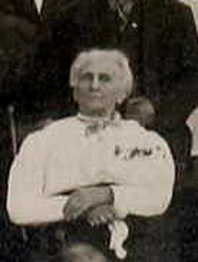
Mary was 79 years old when she died in 1916, 100 years after this article is being written.
Historical Society member Luella Hinrichsen found Mary’s obituary. It said she died after an illness of only a few days, the announcement of which caused “surprise and consternation throughout the community as she had been able to be up town only a few days before.” Her last words were said to have been “Jesus take me.”
She was a Presbyterian who led a “busy, active church life, always interested in church work and in all public movements for the welfare of the community.”
Besides her daughters Awilda and Minnie, four of her nine siblings survived her, her brothers William and Henry and sisters Nancy and Sarah. Neither Awilda nor Minnie had children. Mary was deprived of the satisfaction of holding a grandchild of her own in her arms.
Mrs. Dr. Mary B. Kerns Fox. A name on a tombstone. A war widow left with three little girls. A pioneer woman who proved up her Nebraska homestead. A pioneer woman who practiced medicine for 30 years. A no-nonsense-looking woman with a baby over her shoulder in a group picture. A jewel of our history.
Nancy Kerns Wyman Taylor. A name on a tombstone. A war widow, probably twice over, with three little boys. A pioneer woman who proved up her Nebraska homestead. Another jewel.
Margaret Kerns Craig Wheeler Layman. A name on a tombstone. A pioneer woman left with six children to raise after her husband died of disease contracted during the war. Another jewel.
I hope you have enjoyed seeing these photos of the Kerns family, and will breathe a word of thanks to Dave Leichtman, who shared most of them. If only there were one of Mary's brother John, who died in the war. Not only is there no photo, there is no tombstone, no information about his place of rest. He died at a hospital in Washington, D.C., where he was taken after he became ill. That is the last that is known. Perhaps a trip to the National Archives to view his service record will provide more information, but for now, he is only a name that must have been uttered with sadness by his sisters and brothers.
A photograph alone is just an image. A name alone is just a name. A picture and a name and a story….now there you’ve got something. Now you know something about Mary and the other Kerns family members at rest in the Table Rock Cemetery. If you want to know more, check their obituaries on their Findagrave.com memorials, or ask us.
mary's daughters minnie & awilda
Here they are in this detail from a larger photo, Photo 9861: Awilda, and Wilda's husband Charles Carmichael, on front of the Carmichael home. After Awilda and Charles's death, the home went to niece Linnie Lehman and was known as the Lehman home for many years.
Sources of information for the story about Mary Fox include information provided by genealogist Dave Leichtman (descendant of Mary's sister Sarah Emerald), articles and obituaries in the Table Rock Argus, records for Mary's widow's pension, pension records for Mary's brothers-in-law, military records of Mary's brother John, an extensive genealogy of Reynolds Fox's family (Descendants of Johann Christop Fuchs) and more.
pioneer elizabeth ball
1824-1908
privations of early days...and a horse thief knocking at her door
|
This photo of Elizabeth Ball is one of the amazing collection given to us by Kenneth Boyd. It belonged to his mother, Nellis Ross Griffing Boyd. Nellie was one of the pioneer families who came in the 1856-1857 wave of settlers, and she had pictures of a number of the other early settlers. But for her pictures, we would have no idea what they looked like. This is a detail of Photo 2018.
|
a little baby in vermont
Elizabeth Elva Knowlton. That was the name given a little girl born in Vermont in 1824.
When her mother rocked her in her cradle and thought of the life her daughter might have, she never could have imagined that little Elizabeth would live in Nebraska Territory. It did not exist until 1854. Heck, it had been less than 20 years since the Louisiana Purchase.
And even more impossibly, her mother never could have imagined that this little baby would have even a brief encounter with Paul Joseph Catrin, a wounded horse thief trying to elude a posse. Nor could she have imagined that this little girl and her husband would donate the land upon which a grand Methodist church would be built and which would still stand in 2016.
a young woman in pennsylvania
Her obituary says she was a Free Will Baptist in her younger days. I could find little of Elizabeth before she came to Table Rock beyond the dry facts of the U. S. census.
In 1850, she lived with her mother Sally in Susquehanna County, Pennsylvania. What happened to her father? Did she have any brothers and sisters? Why was she not married by the age of 30? What were her dreams. No census explains such things.
In 1850, a young man by the name of Benjamin Milton Ball also lived in Susquehanna County. He was in a household headed by Ezra M. Ball, age 33, occupation farmer. The household also included Eunice Storm, age 32; Ann, age 64; and Benjamin, age 27. My surmise is that he, his mother (Ann) and widowed sister (Eunice) lived with brother Ezra, who was head of the household. If so, had Ezra been married? What happened to Eunice’s husband, Mr. Storm? What happened to Ann’s husband? Again, the census stands silent.
In 1854, at the age of 30, Elizabeth got married. Ben, by then 31, was the new husband. How did they meet? How long was the courtship?
In 1857, something happened. Both the mother and father of a family, the Doolittles, with whom they were friends died on the same day. They left three little girls. Two went to an uncle. Ben and Elizabeth, childless and married three years, took in the other, three-year-old Emmaroy. Ben's later obituary called Emma his adoptive daughter, but at times -- as on her marriage license -- Emma used the last name Doolittle. Whether she was formally adopted, the Balls considered her theirs and vice versa.
In 1850, she lived with her mother Sally in Susquehanna County, Pennsylvania. What happened to her father? Did she have any brothers and sisters? Why was she not married by the age of 30? What were her dreams. No census explains such things.
In 1850, a young man by the name of Benjamin Milton Ball also lived in Susquehanna County. He was in a household headed by Ezra M. Ball, age 33, occupation farmer. The household also included Eunice Storm, age 32; Ann, age 64; and Benjamin, age 27. My surmise is that he, his mother (Ann) and widowed sister (Eunice) lived with brother Ezra, who was head of the household. If so, had Ezra been married? What happened to Eunice’s husband, Mr. Storm? What happened to Ann’s husband? Again, the census stands silent.
In 1854, at the age of 30, Elizabeth got married. Ben, by then 31, was the new husband. How did they meet? How long was the courtship?
In 1857, something happened. Both the mother and father of a family, the Doolittles, with whom they were friends died on the same day. They left three little girls. Two went to an uncle. Ben and Elizabeth, childless and married three years, took in the other, three-year-old Emmaroy. Ben's later obituary called Emma his adoptive daughter, but at times -- as on her marriage license -- Emma used the last name Doolittle. Whether she was formally adopted, the Balls considered her theirs and vice versa.
to the territory of nebraska
The year Elizabeth was married, 1854, Nebraska Territory was formed. In 1857, their new little girl in tow, she and Ben headed there. They were one of the 150 families sent that way by the Nebraska Settlement Company. Included in that body of immigrants was Ben’s next-door-neighbors, Martin J. Mumford and family, people who would be important to Table Rock, and would furnish two sons to the Union Army in less than a decade, Luther & Henry; Martin and his wife were in their 40s. Most of the families, including Elizabeth and her husband and the Mumfords, were Methodists.
Arriving in Table Rock, Elizabeth and her husband took up farming in the Long Branch area.
In her later years, Elizabeth was known to all as "Auntie Ball," an affectionate appellation bestowed only on the most kindly and well-liked of women in those early days. In her earlier years, Elizabeth had to have been tough to live her new life in the Territory. She must have had many a difficult day and night on the farmstead.
Her early life in Table Rock “was fraught with the dangers and privations incident of the pioneer life, and borne with the courage and determination which characterized the early settlers of Nebraska.” She and Ben “witnessed the transformation of the Nebraska Prairies into the beautiful and productive farms of today.”
The year 1858 was a time of great privation. Flooding left devastating illness in its wake. It was said that so many were ill that there were none left to minister to them. One pioneer, Laura Griffing, recalled becoming ill while caring for her sick husband; neither could get out of bed to do so much as get a drink of water and expected death until the miracle of a healthy neighbor came to care for them. As a result of these hardships, all but 15 families of the original families reportedly left Table Rock. Those that stayed included Elizabeth and her husband and Ben’s old neighbors, the Mumfords.
Elizabeth and her husband stayed, but the following year took a homestead nearer town, to the north, on higher ground. It was on the northeast portion of what came to be known as Horse Shoe Lake. That body of water no longer exists, but for many years it was a significant recreational area here.
Arriving in Table Rock, Elizabeth and her husband took up farming in the Long Branch area.
In her later years, Elizabeth was known to all as "Auntie Ball," an affectionate appellation bestowed only on the most kindly and well-liked of women in those early days. In her earlier years, Elizabeth had to have been tough to live her new life in the Territory. She must have had many a difficult day and night on the farmstead.
Her early life in Table Rock “was fraught with the dangers and privations incident of the pioneer life, and borne with the courage and determination which characterized the early settlers of Nebraska.” She and Ben “witnessed the transformation of the Nebraska Prairies into the beautiful and productive farms of today.”
The year 1858 was a time of great privation. Flooding left devastating illness in its wake. It was said that so many were ill that there were none left to minister to them. One pioneer, Laura Griffing, recalled becoming ill while caring for her sick husband; neither could get out of bed to do so much as get a drink of water and expected death until the miracle of a healthy neighbor came to care for them. As a result of these hardships, all but 15 families of the original families reportedly left Table Rock. Those that stayed included Elizabeth and her husband and Ben’s old neighbors, the Mumfords.
Elizabeth and her husband stayed, but the following year took a homestead nearer town, to the north, on higher ground. It was on the northeast portion of what came to be known as Horse Shoe Lake. That body of water no longer exists, but for many years it was a significant recreational area here.
during the civil war -- an extraordinary event
In 1861, the Civil War broke out.
All heck broke loose with horse stealing,too.
The Jayhawkers from nearby Kansas were supposedly the worst lot, but there was an organized ring of horse thieves out of a place called Rush Bottom, Missouri. Rush Bottom was a lawless little town on the Missouri side of the River just north of Rulo.
Horses were big business. They were not only the means of transportation for all, they were made even more valuable by the war machine. The Army paid top dollar for horses. Old settlers later remembered that not a team of horses was safe and thefts hit the local people hard.
On a winter’s night in 1864, Andrew Fellers caught two of them red-handed. He barely escaped with his life, one of them pulling a gun and saying to the effect of “dead men tell no tales.” The other – later identified as Joseph Catrin– impeded him and Fellers escaped.
The town had a focus for their years of lost horses. They undertook a singularly persistent effort to track the thieves down. In 1893, many of those who were still alive, gathered their memories of that time, in a series of articles in the Table Rock Argus.
An accomplice was reported to be harboring the thieves. When the posse went out there, the thieves were there but with a desperate ride across the fields escaped. They were tracked down eventually and brought back to Table Rock.
The accomplice was lynched without discussion by an apparently intoxicated crowd. The thieves were placed under guard in a boarding house that stood where the Methodist Church now stands.
The crowd decided to lynch the two and headed for the boarding house. When they entered the room, tensions were high, those guarding the men thought the crowd might be coming to rescue the thieves, and shots were fired. Catrin was hit but “with the quickness of an athlete, Catrin was out of the room, jumped through a window, and was out in the darkness and away before the crowd realized what he had done, wounded though he was.”
The other thief they took out and hanged. But where was Catrin?
The wounded Catrin made his way north from town.
He knocked on the door of Elizabeth and Ben's cabin, seeking sanctuary.
All heck broke loose with horse stealing,too.
The Jayhawkers from nearby Kansas were supposedly the worst lot, but there was an organized ring of horse thieves out of a place called Rush Bottom, Missouri. Rush Bottom was a lawless little town on the Missouri side of the River just north of Rulo.
Horses were big business. They were not only the means of transportation for all, they were made even more valuable by the war machine. The Army paid top dollar for horses. Old settlers later remembered that not a team of horses was safe and thefts hit the local people hard.
On a winter’s night in 1864, Andrew Fellers caught two of them red-handed. He barely escaped with his life, one of them pulling a gun and saying to the effect of “dead men tell no tales.” The other – later identified as Joseph Catrin– impeded him and Fellers escaped.
The town had a focus for their years of lost horses. They undertook a singularly persistent effort to track the thieves down. In 1893, many of those who were still alive, gathered their memories of that time, in a series of articles in the Table Rock Argus.
An accomplice was reported to be harboring the thieves. When the posse went out there, the thieves were there but with a desperate ride across the fields escaped. They were tracked down eventually and brought back to Table Rock.
The accomplice was lynched without discussion by an apparently intoxicated crowd. The thieves were placed under guard in a boarding house that stood where the Methodist Church now stands.
The crowd decided to lynch the two and headed for the boarding house. When they entered the room, tensions were high, those guarding the men thought the crowd might be coming to rescue the thieves, and shots were fired. Catrin was hit but “with the quickness of an athlete, Catrin was out of the room, jumped through a window, and was out in the darkness and away before the crowd realized what he had done, wounded though he was.”
The other thief they took out and hanged. But where was Catrin?
The wounded Catrin made his way north from town.
He knocked on the door of Elizabeth and Ben's cabin, seeking sanctuary.
|
The story as preserved in 1893 is written primarily as though it were her husband’s story, but Elizabeth was there virtually every step of the way. Where 13-year-old Emma was is not mentioned, either. I have taken the liberty to modify the story as told in 1893 to account for that without noting the modifications. You can read the original newspaper articles for the original text.
|
“There was little sleep for the people of the village that night, and while a majority of the people did not know what had taken place, yet that feeling of uneasiness and dread was enough to keep sleep from nearly every eye. |
More was said in a later installment:
“Catrin was the brain man of the outfit, was a splendid specimen of physical manhood, a trained athlete, and a man who in almost any honorable calling could have won success, but he had started on a downward course, which had encompassed the destruction of his nobler aspirations, brutalized his nature and deadened the finer possibilities of his character. |
The conclusion appears in a still later installment. As Catrin was cared for at the Balls, townspeople discussed what form of justice to mete out, whether to hang him or to keep him until the distant and uncertain time when a circuit judge came through. After a vote for the hanging, they went to get him.
“The crowd started for Mr. Ball’s house, where Catrin was still confined. Without an apparent tremor, Catrin received the intelligence that a death sentence had just been passed upon him by the outraged citizens and that a crowd was already at the door to carry out the verdict. Without much preliminary work, he was placed on a horse and taken out to a tree about 100 yards from the house” and hung. |
All of these events happened in the home of Elizabeth and Ben Ball. Who was fixing food, cleaning up. Who was listening, perhaps herself speaking? Who washed the bloody bed linens after Catrin was taken away? Who for the next 20 years probably stood hanging clothes or throwing out a pan of dishwater and looked out to the tree from which Catrin had been hung? Elizabeth Knowlton Ball, a pioneer woman of Table Rock, Nebraska.
Where was Emma? She was with Ben and Elizabeth during the 1860 census and the 1870 census, and did not marry until 1874, yet young Emma is unmentioned in any of the accounts. And oddly the account of Paul Catrin was not mentioned in either Elizabeth's or Ben's obituary, as singular as it was. And so history overlooks and forgets.
Where was Emma? She was with Ben and Elizabeth during the 1860 census and the 1870 census, and did not marry until 1874, yet young Emma is unmentioned in any of the accounts. And oddly the account of Paul Catrin was not mentioned in either Elizabeth's or Ben's obituary, as singular as it was. And so history overlooks and forgets.
life in the state of nebraska
Nebraska became a state in 1867. I wonder how Elizabeth celebrated that with her husband and daughter?
They continued to live in the home where so much had happened for another 20 years.
In 1882, those who lived in Lower Town -- which was most of the town – decided to move back to the original town site on the hill. The Methodists had built their first church building in Lower Town and wanted a new building up there.
Elizabeth and Ben had by that time become “earnest members” of the Methodist church.
They donated the lot for the new church, once described as “a monument to their faithfulness.”
It is the church that still stands.
It is the church which stands where the boarding house stood in which the thieves were under guard pending a decision as to whether to hang them. The boarding house where Joseph Catrin was shot and escaped, making his painful way to knock on Elizabeth's door.
In 1884, now entering their 60s, they moved to town.
As did many of the old settlers, “During the latter years of her life she took pleasure in recounting her experiences of early life here and contrasting conditions then and now.”
Elizabeth died of pneumonia when she was 83. She was ill only a few days. “For some time she has not been in good health, and when attacked by pneumonia could not withstand its ravages and she quietly passed to the other world.” At her funeral, friends paid “the last tribute of esteem to whom in life they highly respected.”
Ben went to live with their adopted daughter Emma. Emma had married Civil War veteran Cosmus Snokes in 1874 and born 7 children, 3 of whom had died in infancy. The grandson of Elizabeth's granddaughter says that the family story is that there was a house fire. Two of the triplets died in the fire, the other was saved but lived only for a year. No written account has yet been found. The source if George Marburger of Humboldt. His grandmother Nellie Snoke Marburger, was one of Emma's children.
It was said of Ben that he bore “the latter years of his life with great patience.” The cause of his death, at age 85, was unstated.
Elizabeth and her husband Ben are buried in the beautiful Table Rock Cemetery in a grave marked by a solid, well-made tombstone.
Elsewhere in the same cemetery is the unmarked common grave of the three horse thieves, including Joseph Catrin.
They continued to live in the home where so much had happened for another 20 years.
In 1882, those who lived in Lower Town -- which was most of the town – decided to move back to the original town site on the hill. The Methodists had built their first church building in Lower Town and wanted a new building up there.
Elizabeth and Ben had by that time become “earnest members” of the Methodist church.
They donated the lot for the new church, once described as “a monument to their faithfulness.”
It is the church that still stands.
It is the church which stands where the boarding house stood in which the thieves were under guard pending a decision as to whether to hang them. The boarding house where Joseph Catrin was shot and escaped, making his painful way to knock on Elizabeth's door.
In 1884, now entering their 60s, they moved to town.
As did many of the old settlers, “During the latter years of her life she took pleasure in recounting her experiences of early life here and contrasting conditions then and now.”
Elizabeth died of pneumonia when she was 83. She was ill only a few days. “For some time she has not been in good health, and when attacked by pneumonia could not withstand its ravages and she quietly passed to the other world.” At her funeral, friends paid “the last tribute of esteem to whom in life they highly respected.”
Ben went to live with their adopted daughter Emma. Emma had married Civil War veteran Cosmus Snokes in 1874 and born 7 children, 3 of whom had died in infancy. The grandson of Elizabeth's granddaughter says that the family story is that there was a house fire. Two of the triplets died in the fire, the other was saved but lived only for a year. No written account has yet been found. The source if George Marburger of Humboldt. His grandmother Nellie Snoke Marburger, was one of Emma's children.
It was said of Ben that he bore “the latter years of his life with great patience.” The cause of his death, at age 85, was unstated.
Elizabeth and her husband Ben are buried in the beautiful Table Rock Cemetery in a grave marked by a solid, well-made tombstone.
Elsewhere in the same cemetery is the unmarked common grave of the three horse thieves, including Joseph Catrin.
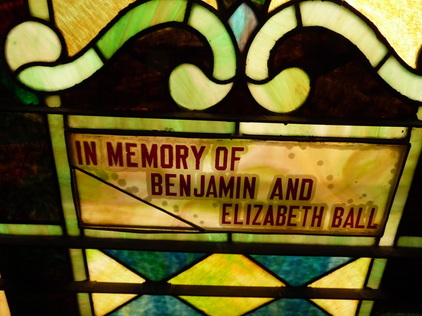
Lower part of a memorial window at the United Methodist Church honoring the memory of Ben and Elizabeth Ball. They donated the land on which the church now stands, and the church has been called a "monument to their faith." Not many people today even notice this window, which is partially obscured by a pew, let alone appreciate who Benjamin and Elizabeth Ball were and what they accomplished in their lives. The window is on the south wall.
Sources for the story about Elizabeth Ball included census records, her obituary and that of her husband, editions of the Table Rock Argus, and Historical Society records.
